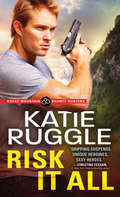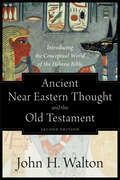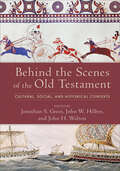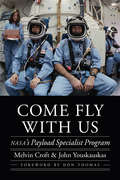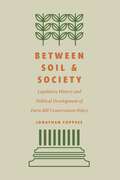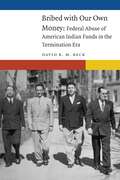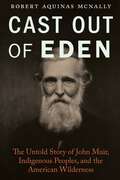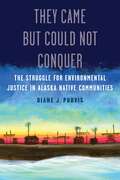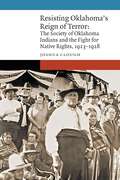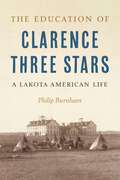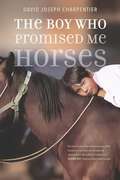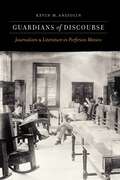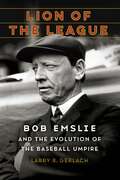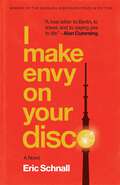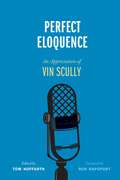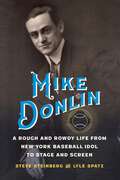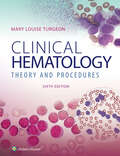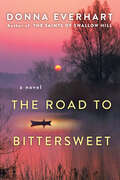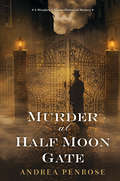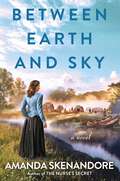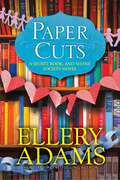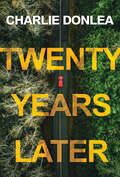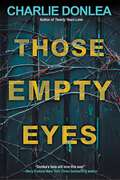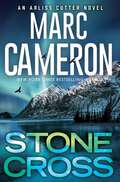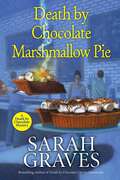- Table View
- List View
Risk It All (Rocky Mountain Bounty Hunters #2)
by Katie RuggleFull of humor and danger, romance and intrigue, Risk it All is for fans of:Romantic suspense with a quirky small town feelMountain men wrapped in flannelA slow burn that steadily turns up the heatAnd complete opposites forced to rely on each other as they trek through the RockiesCara Pax never wanted to be a bounty hunter. She's happy to leave chasing criminals and tackling skips to her sisters. But if she wants her dreams of escaping the family business and becoming a kindergarten teacher to come true, she's got one last job to finish… Only problem is, she doesn't think her bounty is guilty.Henry Kavenski is a man with innocence to prove. When he realizes that Cara believes him, he'll do anything to keep her out of harm's way. Escaping criminals and dodging cops might not be the best time to fall in love, but Henry and Cara won't give up, not when there's a chance at a new life ahead—if they can survive the fall.What Your Favorites Are Saying:"I love Ruggle's characters. They're sharply drawn, and vividly alive. I'm happy when they find each other. These are wonderful escapist books."—CHARLAINE HARRIS, #1 New York Times Bestselling Author of the Sookie Stackhouse series"Sexy and suspenseful, I couldn't turn the pages fast enough."—JULIE ANN WALKER, New York Times and USA Today Bestselling Author, for Hold Your Breath"Chills and thrills and a sexy slow-burning romance from a terrific new voice."—D.D. AYRES, author of the K-9 Rescue series, for Hold Your Breath
Ancient Near Eastern Thought and the Old Testament: Introducing The Conceptual World Of The Hebrew Bible
by John H. WaltonA leading evangelical scholar surveys the cultural context of the ancient Near East, bringing insight to the interpretation of specific Old Testament passages. Now thoroughly updated and revised throughout.
Behind the Scenes of the Old Testament: Cultural, Social, And Historical Contexts
by Jonathan S. Greer;John W. Hilber;and John H. WaltonA team of world-class scholars covers the full range of Old Testament backgrounds studies in a concise, authoritative, and comprehensive manner.
Come Fly with Us: NASA's Payload Specialist Program (Outward Odyssey: A People's History of Spaceflight)
by Melvin Croft John Youskauskas2020 Space Hipsters Prize for Best Book in Astronomy, Space Exploration, or Space HistoryCome Fly with Us is the story of an elite group of space travelers who flew as members of many space shuttle crews from pre-Challenger days to Columbia in 2003. Not part of the regular NASA astronaut corps, these professionals known as &“payload specialists&” came from a wide variety of backgrounds and were chosen for an equally wide variety of scientific, political, and national security reasons. Melvin Croft and John Youskauskas focus on this special fraternity of spacefarers and their individual reflections on living and working in space. Relatively unknown to the public and often flying only single missions, these payload specialists give the reader an unusual perspective on the experience of human spaceflight. The authors also bring to light NASA&’s struggle to integrate the wide-ranging personalities and professions of these men and women into the professional astronaut ranks. While Come Fly with Us relates the experiences of the payload specialists up to and including the Challenger tragedy, the authors also detail the later high-profile flights of a select few, including Barbara Morgan, John Glenn (who returned to space at the age of seventy-seven), and Ilan Ramon of Israel aboard Columbia on its final, fatal flight, STS-107.
Between Soil and Society: Legislative History and Political Development of Farm Bill Conservation Policy
by Jonathan CoppessThe United States spends approximately $5 billion each year on federal programs designed to conserve natural resources and address the environmental consequences of modern agricultural production. Like farm policy, agricultural conservation policy is rooted in the Roosevelt administration&’s New Deal efforts of the 1930s. Farm conservation policy has waxed and waned since then, related to fluctuating economic and environmental concerns. In Between Soil and Society Jonathan Coppess traces the history and development of U.S. conservation policy, especially as it compares to and interacts with the development of farm policy. By answering questions about the differences in political support and development for these similar policy regimes, with efforts to apply legal and political theory to understand the differences, Coppess considers the implications of climate change and lessons for future policy development. One of the few books to make sense of the legal and economic analysis of agricultural conservation policy, Between Soil and Society provides a window into larger issues of American politics, governance, and policy development.
Bribed with Our Own Money: Federal Abuse of American Indian Funds in the Termination Era (New Visions in Native American and Indigenous Studies)
by David R. BeckIn Bribed with Our Own Money David R. M. Beck analyzes the successes and failures of Indigenous nations&’ opposition to federal policy in the 1950s and 1960s. Focusing on case studies from six Native nations, Beck recounts how the U.S. government coerced American Indian nations to accept termination of their political relationship with the United States by threatening to withhold money that belonged to the tribes. Termination was the continuation—and, federal officials hoped, the culmination—of more than a century of policy initiatives intended to end the political relationship between Indian tribal nations and the federal government. Termination was also intended to assimilate American Indian individuals into the country&’s social and economic culture and to remove the remainder of reservation lands from federal trust. American Indians hoped to gain greater opportunities of self-governance and self-determination, but they wanted to do so under the protection of the federal trust relationship.Bribed with Our Own Money analyzes both successful and unsuccessful efforts of Native nations to oppose this policy within the larger context of long-standing federal abuse of tribal funds. It is the first book to view federal termination efforts grounded in bribery for what they were: a form of coercion.
Cast Out of Eden: The Untold Story of John Muir, Indigenous Peoples, and the American Wilderness
by Robert Aquinas McNallyJohn Muir is widely and rightly lauded as the nature mystic who added wilderness to the United States&’ vision of itself, largely through the system of national parks and wild areas his writings and public advocacy helped create. That vision, however, came at a cost: the conquest and dispossession of the tribal peoples who had inhabited and managed those same lands, in many cases for millennia. Muir argued for the preservation of wild sanctuaries that would offer spiritual enlightenment to the conquerors, not to the conquered Indigenous peoples who had once lived there. &“Somehow,&” he wrote, &“they seemed to have no right place in the landscape.&”Cast Out of Eden tells this neglected part of Muir&’s story—from Lowland Scotland and the Wisconsin frontier to the Sierra Nevada&’s granite heights and Alaska&’s glacial fjords—and his take on the tribal nations he encountered and embrace of an ethos that forced those tribes from their homelands. Although Muir questioned and worked against Euro-Americans&’ distrust of wild spaces and deep-seated desire to tame and exploit them, his view excluded Native Americans as fallen peoples who stained the wilderness&’s pristine sanctity. Fortunately, in a transformation that a resurrected and updated Muir might approve, this long-standing injustice is beginning to be undone, as Indigenous nations and the federal government work together to ensure that quintessentially American lands from Bears Ears to Yosemite serve all Americans equally.
They Came but Could Not Conquer: The Struggle for Environmental Justice in Alaska Native Communities
by Diane J. PurvisAs the environmental justice movement slowly builds momentum, Diane J. Purvis highlights the work of Indigenous peoples in Alaska&’s small rural villages, who have faced incredible odds throughout history yet have built political clout fueled by vigorous common cause in defense of their homes and livelihood. Starting with the transition from Russian to American occupation of Alaska, Alaska Natives have battled with oil and gas corporations; fought against U.S. plans to explode thermonuclear bombs on the edge of Native villages; litigated against political plans to flood Native homes; sought recompense for the Exxon Valdez oil spill disaster; and struggled against the federal government&’s fishing restrictions that altered Native paths for subsistence. In They Came but Could Not Conquer Purvis presents twelve environmental crises that occurred when isolated villages were threatened by a governmental monolith or big business. In each, Native peoples rallied together to protect their land, waters, resources, and a way of life against the bulldozer of unwanted, often dangerous alterations labeled as progress. In this gripping narrative Purvis shares the inspiring stories of those who possessed little influence over big business and regulations yet were able to protect their traditional lands and waterways anyway.
Resisting Oklahoma's Reign of Terror: The Society of Oklahoma Indians and the Fight for Native Rights, 1923–1928 (New Visions in Native American and Indigenous Studies)
by Dr. Joshua CloughThe oil and natural gas boom in pre–World War I Oklahoma brought unbelievable wealth to thousands of tribal citizens in the state on whose lands these minerals were discovered. However, as Angie Debo recognizes in her seminal study of the period, And Still the Waters Run, and, more recently, as David Grann does in Killers of the Flower Moon, this affluence placed Natives in the crosshairs of unscrupulous individuals. As a result, this era was also marked by two of the most heinous episodes of racial violence in the state&’s history: the Tulsa Race Massacre of 1921 and the Osage Murders between 1921 and 1925. In Resisting Oklahoma&’s Reign of Terror Joshua Clough details the responses of one largely forgotten Native organization—the Society of Oklahoma Indians (SOI)—to the violence and pillaging of tribal resources during the 1920s. Clough provides historical understanding of its formation and its shared values of intertribal unity, Native suffrage, and protection of Native property. He also reveals why reform efforts were nearly impossible in 1920s Oklahoma and how this historical perspective informs today&’s conflicts between the state and its Indigenous inhabitants. Through this examination of the SOI, Clough fills the historiographic gap regarding formal Native resistance between the dissolution of the national Society of American Indians in 1923 and the formation of the National Congress of American Indians in 1944. Dismissed or overlooked for a century as an inconsequential Native activist organization, the history of the SOI, when examined carefully, reveals the sophistication and determination of tribal members in their struggle to prevent depredations on their persons and property.
The Education of Clarence Three Stars: A Lakota American Life
by Philip BurnhamIn The Education of Clarence Three Stars Philip Burnham tells the life story of the remarkable Packs the Dog, a member of the Minneconjou Lakotas who was born in 1864 east of the Black Hills. His father, Yellow Knife, died when the boy was five, and the family eventually enrolled at Pine Ridge Agency with the Oglalas under an uncle&’s name, Three Stars. In 1879 Packs the Dog joined the first class of Indian students to be admitted to the Carlisle Indian Industrial School. An enthusiastic student, Clarence Three Stars, as he would come to be known, was one of five Lakota children who volunteered to stay at Carlisle after the three-year plan of instruction was finished—though he eventually left the school in frustration. Three Stars returned to Pine Ridge and married Jennie Dubray, another Carlisle veteran, and they had seven children. The life of Lakota advocate Three Stars spanned a time of dramatic change for Native Americans, from the pre-reservation period through the Dawes Act of 1887 until just before the Indian Reorganization Act of 1934. Three Stars was a teacher, interpreter, catechist, lawyer, and politician who lived through the federal policy of American Indian assimilation in its many guises, including boarding school education, religious conversion, land allotment, and political reorganization. He used the fundamentals of his own boarding school education to advance the welfare of the Oglala Lakota people, even when his efforts were deemed threatening or subversive. His dedication to justice, learning, and self-governance informed a distinguished career of classroom excellence and political advocacy on his home reservation of Pine Ridge.
The Boy Who Promised Me Horses
by David Joseph Charpentier&“He tried to outrun a train,&” Theodore Blindwoman told David Joseph Charpentier the night they found out about Maurice Prairie Chief&’s death. When Charpentier was a new teacher at St. Labre Indian School in Ashland, Montana, Prairie Chief was the first student he met and the one with whom he formed the closest bonds. From the shock of moving from a bucolic Minnesota college to teach at a small, remote reservation school in eastern Montana, Charpentier details the complex and emotional challenges of Indigenous education in the United States. Although he intended his teaching tenure at St. Labre to be short, Charpentier&’s involvement with the school has extended past thirty years. Unlike many white teachers who came and left the reservation, Charpentier has remained committed to the potentialities of Indigenous education, motivated by the early friendship he formed with Prairie Chief, who taught him lessons far and wide, from dealing with buffalo while riding a horse to coping with student dropouts he would never see again. Told through episodic experiences, the story takes a journey back in time as Charpentier searches for answers to Prairie Chief&’s life. As he sits on top of the sledding hill near the cemetery where Prairie Chief is buried, Charpentier finds solace in the memories of their shared (mis)adventures and their mutual respect, hard won through the challenges of educational and cultural mistrust.
Guardians of Discourse: Journalism and Literature in Porfirian Mexico
by Kevin M. AnzzolinDuring Porfirio Díaz&’s thirty-year rule, Mexico dealt with the press in disparate ways in hopes of forging an informed and, above all, orderly citizenry. Even as innumerable journalists were sent to prison on exaggerated and unfair charges of defamation or slander, Díaz&’s government subsidized multiple newspapers to expand literacy and to aggrandize the image of the regime. In Guardians of Discourse Kevin M. Anzzolin analyzes the role and representation of journalism in literary texts from Porfirian Mexico to argue that these writings created a literate, objective, refined, and informed public. By exploring works by Porfirian writers such as Emilio Rabasa, Ángel del Campo, Rafael Delgado, Laura Méndez de Cuenca, and Salvador Quevedo y Zubieta, Anzzolin demonstrates that a primary goal of the lettered class was to define and shape the character of public life, establish the social position of citizens, and interrogate the character of civil institutions. These elite letrados—whom Anzzolin refers to as &“guardians of discourse&”—aimed to define the type of discourses that would buttress the transformed Mexico of the Díaz regime to forge a truly national literature that could be discussed among an expanded coterie of lettered thinkers. In addition, these Porfirian guardians hoped to construct an extensive and active public able to debate political and social issues via a press befitting a modern nation-state and create a press that would be independent, illuminating, and distinguished. Through an innovative look at Mexico&’s public sphere via literary fiction in the Porfirian era, Anzzolin contributes to our knowledge of Mexican and Latin American political, cultural, and literary history in the late nineteenth and early twentieth centuries.
Lion of the League: Bob Emslie and the Evolution of the Baseball Umpire
by Larry R. GerlachRobert Dean Emslie (1859–1943) spent fifty-six of his eighty-four years in professional baseball—eight as a player and forty-nine as an umpire. When arm problems ended his career as a Major League pitcher, he turned to umpiring, serving in that capacity for thirty-five seasons, then as an umpire supervisor for thirteen years. His longevity is all the more remarkable considering he toiled during the three most contentious and difficult decades umpires ever faced: the years from 1890 to 1920, when baseball transitioned from amateur to professional sport and from regional business to commercial entertainment industry. Emslie endured the rough-and-tumble umpire-baiting 1890s, the Deadball era, injuries from thrown and batted balls, physical and verbal assaults from players and fans, and criticism in the press. Among his most notable games, he called four no-hitters and worked as the base umpire in the famous Merkle&’s Boner game between the New York Giants and the Chicago Cubs at the Polo Grounds in 1908. He often clashed with Giants manager John McGraw, who nicknamed him &“Blind Bob.&” Yet he was widely praised by players and his peers. Honus Wagner, the great Pittsburgh shortstop, ranked Emslie the best National League umpire he had seen during his twenty-year career. Umpires Bill McGowan and Billy Evans respectively regarded him as &“the greatest base umpire of all time&” and &“one of the greatest umpires the game ever produced.&” Emslie was also the acknowledged master of baseball&’s rules such that National League presidents regularly consulted with him on controversial calls and protests. Emslie accepted a position as the chief of National League umpires, serving as an adviser to the National League president.Lion of the League is the biography of an umpire whose career spanned the formative years of modern baseball.
I Make Envy on Your Disco: A Novel (Zero Street Fiction)
by Eric SchnallWinner of the Barbara DiBernard Prize in Fiction It&’s the new millennium and the anxiety of midlife is creeping up on Sam Singer, a thirty-seven-year-old art advisor. Fed up with his partner and his life in New York, Sam flies to Berlin to attend a gallery opening. There he finds a once-divided city facing an identity crisis of its own. In Berlin the past is everywhere: the graffiti-stained streets, the candlelit cafés and techno clubs, the astonishing mash-up of architecture, monuments, and memorials. A trip that begins in isolation evolves into one of deep connection and possibility. In an intensely concentrated series of days, Sam finds himself awash in the city, stretched in limbo between his own past and future—in nightclubs with Jeremy, a lonely wannabe DJ; navigating a flirtation with Kaspar, an East Berlin artist he meets at a café; and engaged in a budding relationship with Magda, the enigmatic and icy manager of Sam&’s hotel, whom Sam finds himself drawn to and determined to thaw. I Make Envy on Your Disco is at once a tribute to Berlin, a novel of longing and connection, and a coming-of-middle-age story about confronting the person you were and becoming the person you want to be.
Perfect Eloquence: An Appreciation of Vin Scully
by Ron RapoportWhen Vin Scully passed away in 2022, the city of Los Angeles lost its soundtrack. If you were able to deliver a eulogy for him, what might it include? What impact did he have on you? What do you carry forward from his legacy? Sixty-seven essayists—one representing each season of his career calling games for the Los Angeles Dodgers, from 1950 through 2016—reflect on the ways his professional and private life influenced them. The contributions include a range of stories and remembrances from those who knew and followed him. The consensus of the contributions is that Scully&’s actions spoke louder than his well-recognized words. This collection includes fellow broadcasters as well as historians, players, journalists, celebrities, and others connected to the game of baseball, with each piece introduced by sports journalist Tom Hoffarth. Readers can consider Scully&’s life through common themes: his sincerity, his humility, his professionalism, his passion for his faith, his devotion to his family, his insistence on remembering and giving context to important moments in the history of not just the game but the world in general, all wrapped up in a gift for weaving storytelling with accurate reporting, fellowship with performance art, humor, and connection.
Mike Donlin: A Rough and Rowdy Life from New York Baseball Idol to Stage and Screen
by Steve Steinberg Lyle SpatzMike Donlin was a brash, colorful, and complicated personality. He was the most popular athlete in New York and was a star on the powerful New York Giants teams of 1905 and 1908. Though haunted by tragedy, including the deaths of both of his parents as a boy, Donlin was a charming, engaging, and kind-hearted man who also had successful careers on the stage and in film. One of the early &“bad boys&” among professional athletes, Donlin&’s temper and combativeness—compounded by alcoholism—led to battles with umpires and fans, numerous suspensions from the game, and even jail time. In 1906, when Donlin married vaudeville actress Mabel Hite, his life changed for the better, and their love story captivated the nation. Donlin left baseball after his sensational comeback for the dramatic 1908 season and joined Mabel on the stage, likely losing a Hall of Fame career. Then in 1912, at the age of twenty-nine, Mabel died of intestinal cancer. After making a final comeback as a player in 1914, Donlin starred in baseball&’s first feature film. He became a drinking buddy of actors John Barrymore and Buster Keaton and married actress Rita Ross. The couple moved to Hollywood, where Donlin became a beloved figure and appeared in roughly one hundred movies, mostly in minor roles. Despite his Hollywood career, Donlin stayed connected to the game he loved and was seeking a coaching job with the Giants when he died of a heart attack in 1933. At the dawn of the celebrity era of sports, Donlin was one of the nation&’s first athletes to capture the public&’s attention. This biography by Steve Steinberg and Lyle Spatz shows why.
Clinical Hematology: Theory and Procedures
by Mary Lou TurgeonDesigned to help students develop the professional entry-level competencies they need for certification and career success, this Sixth edition of Clinical Hematology strengthens the pedagogy that set the quality benchmark for hematology and includes the current, competency-based content needed by MLT and MLS students. In addition to state-of-the-art content, many, fully developed case studies with critical thinking discussion questions, and a strong emphasis on emerging molecular diagnostics and genomic medicine, the 6th edition encompasses the professional knowledge guidelines recommended by ASCLS Entry Level and Professional Body of Knowledge competencies in hematology, hemostasis and coagulation, and molecular applications. Throughout the text, a logical eight-part organization, clear explanations, and multiple learning tools help students master the theory underlying clinical hematology and the procedures used to diagnose and treat disorders of the blood and bone marrow.
The Road to Bittersweet
by Donna EverhartSet in the Carolinas in the 1940s, The Road to Bittersweet is a beautifully written, evocative account of a young woman reckoning not just with the unforgiving landscape, but with the rocky emotional terrain that leads from innocence to wisdom. For fourteen-year-old Wallis Ann Stamper and her family, life in the Appalachian Mountains is simple and satisfying, though not for the tenderhearted. While her older sister, Laci—a mute, musically gifted savant—is constantly watched over and protected, Wallis Ann is as practical and sturdy as her name. When the Tuckasegee River bursts its banks, forcing them to flee in the middle of the night, those qualities save her life. But though her family is eventually reunited, the tragedy opens Wallis Ann&’s eyes to a world beyond the creek that&’s borne their name for generations. Carrying what&’s left of their possessions, the Stampers begin another perilous journey from their ruined home to the hill country of South Carolina. Wallis Ann&’s blossoming friendship with Clayton, a high diving performer for a traveling show, sparks a new opportunity, and the family joins as a singing group. But Clayton&’s attention to Laci drives a wedge between the two sisters. As jealousy and betrayal threaten to accomplish what hardship never could—divide the family for good—Wallis Ann makes a decision that will transform them all in unforeseeable ways . . .
Murder at Half Moon Gate (A Wrexford & Sloane Mystery #2)
by Andrea PenroseAs the Industrial Revolution roils London, &“a daring pair of Regency sleuths tackle a series of coldblooded murders&” in this historical mystery (Kirkus Reviews). When the eminent scientist Lord Wrexford discovers the body of a gifted inventor in a dark London alley, he promptly alerts the authorities. But Wrexford soon finds himself drawn into the murder investigation when the inventor&’s widow tells him that the crime was no random robbery. Her husband&’s designs for a new steam-powered engine went missing the night of his death. The plans could be worth a fortune . . .and very dangerous in the wrong hands. Joining Wrexford in his investigation is Charlotte Sloane, who publishes scathing political cartoons under the pseudonym A. J. Quill. Her extensive network of informants is critical for her work—and for tracking down the occasional killer. The suspects include ambitious assistants, greedy investors, and even the inventor&’s widow. And when another victim falls, Wrexford and Sloane know they are on the trail of a cunning and deadly foe. &“Penrose deftly combines a Regency romance with a tricky mystery that delves into social unrest and the darker side of this storied period.&” —Kirkus Reviews
Between Earth and Sky
by Amanda SkenandoreIn Amanda Skenandore’s provocative and profoundly moving debut, set in the tragic intersection between white and Native American culture, a young girl learns about friendship, betrayal, and the sacrifices made in the name of belonging. On a quiet Philadelphia morning in 1906, a newspaper headline catapults Alma Mitchell back to her past. A federal agent is dead, and the murder suspect is Alma’s childhood friend, Harry Muskrat. Harry—or Asku, as Alma knew him—was the most promising student at the “savage-taming” boarding school run by her father, where Alma was the only white pupil. Created in the wake of the Indian Wars, the Stover School was intended to assimilate the children of neighboring reservations. Instead, it robbed them of everything they’d known—language, customs, even their names—and left a heartbreaking legacy in its wake. The bright, courageous boy Alma knew could never have murdered anyone. But she barely recognizes the man Asku has become, cold and embittered at being an outcast in the white world and a ghost in his own. Her lawyer husband, Stewart, reluctantly agrees to help defend Asku for Alma’s sake. To do so, Alma must revisit the painful secrets she has kept hidden from everyone—especially Stewart. Told in compelling narratives that alternate between Alma’s childhood and her present life, Between Earth and Sky is a haunting and complex story of love and loss, as a quest for justice becomes a journey toward understanding and, ultimately, atonement.
Paper Cuts: An Enchanting Cozy Mystery (A Secret, Book, and Scone Society Novel #6)
by Ellery AdamsMiracle Springs, North Carolina, is famed for its healing springs. But bookstore owner Nora Pennington has a tendency to land in a different kind of hot water. Though she loves to practice bibliotherapy by finding the perfect books for her customers while listening to their secrets, she also likes to bury her nose in the occasional local crime . . . Nora escaped her past a decade ago. So it feels like a visit from another world when Kelly Walsh—the woman her ex-husband left her for—walks through the door of Miracle Books along with her son. Kelly hasn&’t come to gloat, though. As it turns out, she&’s been dumped too. She&’s also terribly ill, and all she wants from Nora is forgiveness. Shockingly, however, this woman who&’s been the victim of so much misfortune is about to become a murder victim. Who would do such a thing? Certainly not Nora, but that doesn&’t stop the gossip and suspicion—especially after Kelly&’s brother claims that he saw the two women arguing. In seeking justice for Kelly, The Secret, Book, and Scone Society joins forces with the sheriff&’s department, but they&’ve barely begun their probe when life throws another wrench. After serving a twenty-year sentence, Estella&’s father returns to Miracle Springs. And when his past comes back to haunt him, it might be more than the four friends can handle.
Twenty Years Later: A Riveting New Thriller
by Charlie Donlea&“Excellent…Donlea tells a propulsive tale.&” – The New York TimesThe New York Times Best Thrillers This Season | E! NewsRecommended Books | Overdrive Biggest Books of the MonthFans of Verity by Colleen Hoover won&’t want to miss this thrilling new suspense novel from the #1 internationally bestselling author of The Girl Who Was Taken! Hiding her own dark past in plain sight, a TV reporter is determined to uncover the truth behind a gruesome murder decades after the investigation was abandoned. But TWENTY YEARS LATER, to understand the present, you need to listen to the past… Avery Mason, host of American Events, knows the subjects that grab a TV audience&’s attention. Her latest story—a murder mystery laced with kinky sex, tragedy, and betrayal—is guaranteed to be ratings gold. New DNA technology has allowed the New York medical examiner&’s office to make its first successful identification of a 9/11 victim in years. The twist: the victim, Victoria Ford, had been accused of the gruesome murder of her married lover. In a chilling last phone call to her sister, Victoria begged her to prove her innocence. Emma Kind has waited twenty years to put her sister to rest, but closure won&’t be complete until she can clear Victoria&’s name. Alone she&’s had no luck, but she&’s convinced that Avery&’s connections and fame will help. Avery, hoping to negotiate a more lucrative network contract, goes into investigative overdrive. Victoria had been having an affair with a successful novelist, found hanging from the balcony of his Catskills mansion. The rope, the bedroom, and the entire crime scene was covered in Victoria&’s DNA. But the twisted puzzle of Victoria&’s private life is just the beginning. And what Avery doesn't realize is that there are other players in the game who are interested in Avery&’s own secret past—one she has kept hidden from both the network executives and her television audience. A secret she thought was dead and buried . . . Accused of a brutal murder, Victoria Ford made a final chilling call from the North Tower on the morning of 9/11. Twenty years ago, no one listened. Today, you will.&“Breathtaking pacing and clever plot twists.&” —Publishers Weekly &“An entertaining thriller…surprises lurking around every corner.&” —Kirkus Reviews &“A superb storyteller.&” —Robert Dugoni, New York Timesbestselling author
Those Empty Eyes: A Chilling Novel of Suspense with a Shocking Twist
by Charlie Donlea"Draws readers in from the first heart-stopping pages and doesn't let go until the end." – Mary Kubica, New York Times bestselling author of Local Woman MissingThe bestselling author of Twenty Years Later and master of modern suspense is back with a brilliantly twisting, skillfully plotted thriller perfect for fans of Jeneva Rose and Colleen Hoover&’s Verity. Alex Armstrong has changed everything about herself—her name, her appearance, her backstory. She&’s no longer the terrified teenager a rapt audience saw on television, emerging in handcuffs from the quiet suburban home the night her family was massacred. That girl, Alexandra Quinlan, nicknamed Empty Eyes by the media, was accused of the killings, fought to clear her name, and later took the stand during her highly publicized defamation lawsuit that captured the attention of the nation. It&’s been ten years since, and Alex hasn&’t stopped searching for answers about the night her family was killed, even as she continues to hide her real identity from true crime fanatics and grasping reporters still desperate to locate her. As a legal investigator, she works tirelessly to secure justice for others, too. People like Matthew Claymore, who&’s under suspicion in the disappearance of his girlfriend, a student journalist named Laura McAllister. Laura was about to break a major story about rape and cover-ups on her college campus. Alex believes Matthew is innocent, and unearths stunning revelations about the university&’s faculty, fraternity members, and powerful parents willing to do anything to protect their children. Most shocking of all—as Alex digs into Laura&’s disappearance, she realizes there are unexpected connections to the murder of her own family. For as different as the crimes may seem, they each hinge on one sinister truth: no one is quite who they seem to be . . .&“Engrossing…not to be missed.&” – Publishers Weekly STARRED REVIEW
Stone Cross: An Action-Packed Crime Thriller (An Arliss Cutter Novel #2)
by Marc CameronThis atmospheric Alaskan mystery for fans of Paul Doiron, Jane Harper, and C.J. Box builds to a breakneck pace against the forbidding, majestic wilderness of America&’s final frontier, as Deputy US Marshal Arliss Cutter searches for a stone-cold killer in western Alaska&’s most remote Native village… "Cameron&’s novels hook you from the first line, cement your eyes to the page, and grip your heart in a vice. I can&’t think of another writer whose work I admire more." —WILLIAM KENT KRUEGER "A double-barreled blast of action, narrative, and impossible-to-fake authenticity.&” —CJ BOX Winter comes early to the rural native community of Stone Cross, Alaska—and so does hunting season. Caribou and moose are a major source of food through the long, dark months ahead. But Arliss Cutter has come here for a very different game. A federal judge is receiving death threats and refuses protection. Cutter and his deputy Lola Teariki have been assigned to shadow him on his trip to this icy outland to make sure that he&’s safe. But they quickly discover that no one is ever really safe in a place like this. And no one is above suspicion . . . When Cutter and Lola arrive, the village is already gripped with fear. A young couple has disappeared from their fishing lodge, just eight miles upriver. Their handyman has been found dead, next to a crude drawing of a mysterious symbol. To make matters worse, a dense fog has descended on the region, isolating the town from civilization. With the judge&’s life still at risk, and two people still missing, Cutter and Lola have their work cut out for them. But navigating the small-town customs and blood-bound traditions of this close-knit community won&’t be easy. When the secrets come out, the deadly hunt is on . . .&“Looking for authentic action, suspense, drama, and mystery? Look no further than U.S. Marshals Service veteran Marc Cameron whose thrillers capture the visceral nature of life in the trenches as only one who has lived it truly can.&”—JACK CARR &“Cameron&’s books are riveting page-turners.&” —MARK GREANEY
Death by Chocolate Marshmallow Pie (A Death by Chocolate Mystery #6)
by Sarah GravesThe island village of Eastport, Maine, is full of delights—including the delicious treats sold at The Chocolate Moose, the waterfront bakery run by Jacobia &“Jake&” Tiptree and Ellie White. But a new bakery in town is proving that you can have too much of a good thing . . . Summer in Eastport means lobsters and blueberries, though tourists and locals alike always leave a little room for baked goods from the Chocolate Moose. This year&’s arts fair means even more sweet-toothed customers. But it&’s also bringing competition from a new rival, Choco&’s, trying to slice into the action. Choco&’s owner, Brad Fairway, is pulling sneaky stunts to divert Moose patrons to his own shop, and Ellie finally confronts him about his tactics. But when Brad is found dead the next day—and the weapon is a gun that belongs to Ellie—it&’s only a matter of time before she is charged with the crime. Sifting through the victim&’s connections, Jake and Ellie sense they&’re getting close to the real culprit—a little too close. Can they serve up the solution before the killer dishes up another helping of murder?
